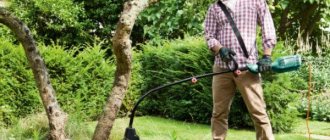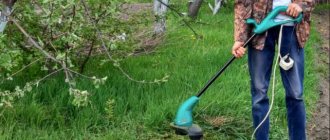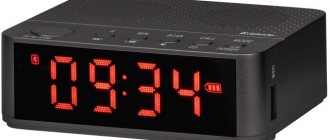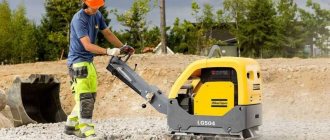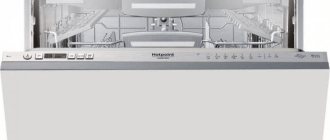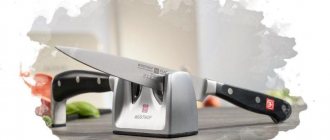Types of vibrating plates
Vibrating plates are mainly divided into categories according to the type of power supply:
- Gasoline. The models are considered optimal in quality and price, demonstrate good performance and low noise levels.
Suitable for refueling gasoline vibratory plates, including low octane fuels - Diesel. Fuel for such models is cheap, but the units themselves are quite expensive, and they also cannot operate at low temperatures.
Diesel vibrating plates make a lot of noise when working - Electrical. Vibrating plates of this type are the cheapest, but they only work close to the power grid and have low power.
Electric vibrating plates do not produce emissions and are suitable for indoor use
When purchasing a unit, you need to take into account the scale of the work, its complexity and how often the equipment is required.
Device and principle of operation
The main part of the vibrating plate consists of a heavy platform with an eccentric installed on it, which rotates due to the motor. There are engines: diesel, gasoline, electric. If the latter (electric) is present, the eccentric is built-in and can be adjusted. If the equipment has a fuel motor, the eccentric comes separately and is connected to the structure by a belt drive.
The most popular of the three types is the gasoline vibrating platform, as it does not require constant power. The electric option is cheaper, but it cannot work autonomously. When operating an electric vibrating plate, you often have to wet the soil with water, which can negatively affect the performance of the equipment.
The main indicators of a vibrating plate are mass and area. The engine power, as well as how tightly and deeply the material will be pressed, directly depends on these characteristics. The force with which the mechanism presses on the ground is determined by the vibration force coefficient. Huge and powerful vibrating platforms can compact the soil deeper than 90 cm.
The vibrating plate can move using vibration. An important point here is the ratio of motor power and weight of the unit itself. Take this into account when assembling the vibrating plate with your own hands. Remember that the normal ratio is 5 liters. With. (approximately 3.5 kW) per 100 kg of vibrating platform weight.
You can change the direction of movement of the unit; if there is a reverse rotation function, it must be on devices whose weight exceeds 100 kg. If you do not have heavy equipment, you can deploy it manually.
How to choose a vibrating plate
The choice of a specific model depends primarily on the specifics of the upcoming work. It is necessary to determine what kind of material is to be compacted and to what depth.
Which vibrating plate is better - gasoline or electric?
In terms of cost, electric units remain the most affordable. But their performance is low, on average up to 2200 W, and besides, the equipment must be provided with access to an outlet. The main advantage of such models is that during operation you do not have to spend money on fuel.
Gasoline devices are more expensive and require regular refilling with liquid fuel. But they are completely autonomous, and with their help you can compact soil, crushed stone and asphalt. Choosing an electric or gasoline vibrating plate depends on the specifics of the work, but the range of applications is wider for liquid fuel models.
How to choose a slab for soil compaction
For compacting soil, asphalt and backfilling foundations, medium-heavy models weighing up to 220 kg are used. This technique compacts the material to a depth of 60 cm and is often used in road construction and repair.
Which vibrating plate to choose for crushed stone and sand
Light units up to 75 kg with a compaction depth of 15 cm work with sand, fine gravel and crushed stone. They are often used when choosing a vibrating plate for a summer house; the models are suitable for landscaping and backfilling garden paths.
How to choose a vibrating plate for laying paving slabs
Paving slabs are a rather fragile material that requires careful handling. It is laid using universal units weighing up to 110 kg with a compaction depth of up to 25 cm and an impact force of up to 12 kN.
Important! A vibrating plate for paving must be equipped with a rubber or polyurethane mat; it will reduce the destructive effects of vibration.
Working area of the plate
The performance of the unit depends on the size of the sole. In the garden, devices with a base of about 40 by 40 cm are usually used.
Reverse
Some models of vibrating plates are equipped with reverse - an option that allows you to start moving in the opposite direction. This feature is convenient when working in difficult terrain areas where heavy equipment may rest against a wall or other obstacle.
Irrigation system
If you plan to work with asphalt or bitumen, it is better to buy a vibrating plate with built-in irrigation. The sole of such models is automatically wetted with water, so viscous and sticky materials do not stick to it.
Which vibrating plate manufacturer is better to choose?
Vibrating plates on the construction market are represented by both foreign and domestic brands. Among the most reliable are:
- Weber;
- Mikasa;
- Shatal;
- Zitrek;
- Grost;
- Caliber;
- MISSOM;
- TCC;
- Impulse.
The listed manufacturers supply durable and high-quality professional-grade equipment in a wide range.
Rules for compacting using a vibrating plate
Each building material has its own properties and characteristics that must be taken into account when choosing the mass of a vibrating plate. Depending on the mass of vibrating plates there are:
- Lightweight equipment with a weight of up to 75 kg is suitable for compacting soil and loose compounds in a layer of up to 15 cm. It is used for laying various types of paving slabs, in the preparation of garden areas and paths.
- Universal models with a weight of 75-90 kg are used for bulk material, the layer of which does not exceed 25 cm. This type of equipment is in demand for partial road repairs and asphalt laying.
- Medium-heavy equipment weighing from 90 to 140 kg is used on sites where the layer of material is up to 60 cm. This technique is used to compact the backfill of pits and trenches during the construction of road embankments.
- Heavy vibration equipment weighing more than 140 kg. The equipment is used for the same work as medium-heavy equipment.
When working with a vibrating plate, you need to follow a few simple rules:
- Work must be carried out systematically and consistently.
- If, according to technology, the pillow must be multi-layered, then each layer is compacted separately.
- Individual sections cannot be skipped.
- The quality of building materials must be checked, deviations from GOST are not allowed.
- The site must be level, differences in height are permissible no more than 2 cm.
- It is necessary to constantly monitor the compliance of the capabilities of the vibrating plates and the thickness of the layer being processed.
- The number of passes with the slab depends on the specific conditions, optimally - from 4 to 6 times.
The rotation speed on the vibrating plate is as follows: the higher the frequency, the more convenient it is to process fine-grained soils. So, for example, for compacting crushed stone or gravel with the size of individual pebbles up to 10 mm (or less), equipment with 6,000 rpm is well suited. If the stone is 6 cm in size, then you can use a device with 3,000 rpm.
Rating of gasoline vibrating plates up to 70 kg
Gasoline light units can be used for laying tiles in the country or compacting crushed stone. Such models are in high demand due to their versatility, although they can be quite expensive.
Mikasa MVH-R60E
The compact Japanese vibrating plate weighs 69 kg and is suitable for laying sand and asphalt. It has good performance and a power of 4.5 liters. s., equipped with a water tank. When interacting with a hot coating, it is prevented from sticking to the work surface.
The average cost of a Mikasa vibrating plate is 229,000 rubles
TSS WP50-L
The unit with an impact force of 8.2 kN compacts 20 cm. Suitable for laying loose and hard coatings in a summer cottage, it is equipped with a powerful four-stroke 2.8 hp engine. The weight of the device is only 54 kg.
You can buy TSS WP50-L from 20,000 rubles
Champion PC5332F
A linear vibratory plate with a compaction depth of 20 cm is capable of processing areas of 480 m2 per hour. It is operated manually, weighs only 43 kg and is suitable for working with tiles and loose coatings. It has compact dimensions, so it is easy to find a place for the unit in a garage or shed in the country.
The average price of a Champion vibrating plate is 21,000 rubles.
Rating of the best models of gasoline vibrating plates over 70 kg
Heavy and medium-weight aggregates are rarely used for decorative tiles. But they are well suited for compacting soil and crushed stone.
DDE VP80-CK
The 80 kg vibrating plate has a rigid frame and a reliable design that is resistant to vibrations. Suitable for landscaping and road laying, compacts soil up to 30 cm deep. Engine power is 6.5 liters. pp., and the only disadvantages include the lack of reverse motion.
The average price of a DDE VP80 vibrating plate is 33,000 rubles
Champion PC1645RH
Powerful 9 liter unit. With. with a mass of 161 kg it is capable of compacting material up to 50 cm in depth. It is used in both private and professional construction, equipped with forward motion and reverse. Starts manually, has low noise level.
You can buy a vibrating plate PC1645RH from 108,000 rubles
Zitrek CNP 25-2
The unit is suitable for working with bulk materials, supports forward and reverse motion, and has a power of 6.5 liters. With. The model is reliably protected from corrosion, easy to operate, and weighs 126 kg. The compaction depth for the unit is 30 cm.
You can purchase a Zitrek vibrating plate from 52,000 rubles
Rating of diesel vibrating plates
Diesel units have the highest power. They are expensive, so they are usually bought for landscaping spacious areas or for production purposes.
Wacker Neuson DPU 3050 H
A powerful professional plate with a productivity of more than 650 m2 per hour compacts soil 50 cm with an impact force of 30 kN. The unit is equipped with a reliable diesel engine with a fuel consumption of 0.6 liters, copes with any tasks and is used in the construction industry.
You can buy a Wacker Neuson diesel unit from 450,000 rubles
Zitrek CNP 330A-3 AES
An expensive but high-quality vibrating plate has a power of 13 hp. With. and impact force 40 kN. Compacts almost 1 m deep, ideal for laying bulk materials and asphalt. It is rarely used in the country, but for construction it is very convenient to buy a model.
The average cost of the Zitrek CNP 330A-3 vibrating plate is 200,000 rubles
Masalta MSH160R-1S
Device with a 4.3 liter diesel engine. With. allows you to compact soil in areas with difficult terrain, near curbs and streetlights. Suitable for preparing road surfaces. The impact force of the unit is 30 kN, the device is compact, despite the increased power.
You can purchase a Masalta vibrating plate from 134,000 rubles
Do-it-yourself vibrating plate: instructions
A vibrator for laying paving slabs on your own is a good saving of money, since of course the price will be up to 10,000 rubles, while a new one will cost significantly more. The first thing is to select a suitable engine. This is the main expense, since the bulk of the money will go to him. You can choose either a mains-powered engine or a non-gasoline engine. We do not take into account diesel ones, since they are expensive and it is not expensive to purchase them just for laying paving slabs. If after its installation you plan to actively use it, then you can consider it, but otherwise you need the power of even an electric vibrator. When, see if the electric motor can operate from a 220 V network, since three-phase power supply is very problematic to provide in the country. Carefully study the IV-98E and IV-99E models. If you already have an old engine, then your costs will drop sharply and will not amount to only 2-3 thousand.
Rating of the best electric vibrating plates by reliability
Although electric models are considered the least powerful, they are often purchased for personal use. The best units show good performance and do not require additional fuel costs.
Shatal PC-1443
The electrically driven device has a 3 liter motor. s., but demonstrates an impact force of 13.5 kN. Compacts over 20 m of soil per minute, copes well with hard and loose materials.
Attention! The advantages of the model include a vibration damping system, which reduces the risk of damage to the tiles during installation.
The average price of Shatal PC-1443 is 120,000 rubles
Stroymashservice IE-4509 A
An electric vibrating plate compacts surfaces up to a maximum of 20 cm. It consumes 250 W of energy and can be powered from a household outlet. With modest capabilities, it is well suited for use in a summer cottage where increased power is not needed.
The average price of a Stroymashservice vibrating plate is 27,700 rubles
Red beacon VU-05-45
A domestic unit with an electric drive for a summer residence copes well with sand and loose gravel, compacting them up to 15 cm deep. The engine is quite weak, only 0.5 liters. pp., but the device can be connected to an outlet.
You can buy a Red Lighthouse vibrating plate from 25,000 rubles
Paving slabs 2. compaction with vibrating plate
Paving slabs
.
final work. The platform is the second important detail. We recommend that you choose steel sheets, and its size should be 80x45 cm, and its thickness should be at least 8 mm. The weight should be 60 kg, maybe a little more, but in no case less. So, these two parts are the main ones, and the most important costs will be incurred on them. But in addition to them, you will also need smaller purchases:
- Small wheels, taken, for example, from a cart or garden wheelbarrow - 2 pcs.;
- Pipes (pieces) for wheels;
- Channels allowing the vibrator to be attached to the base – 2 pcs.;
- The long pipe from which the handle will be made is 1.2 m;
- Engine bolts. For gasoline - M12, for electric M10;
- Elastic pillows – 2 pcs.
You will also need a grinder, a welding machine and ordinary plumbing tools. Next, they begin to assemble the vibrating plate. At the first stage, it is necessary to remove the cover from the electric motor, as this will help regulate the strength of vibration. Armed with a grinder, an incision is made on the metal sheet, 10 cm from the edge, of small depth (about 5 mm). Such cuts are made symmetrically on both sides. Their edges must be bent by 20-30 degrees with a hammer to prevent the machine from burying in the ground in the future. The position of the ends is fixed, and the places of the cuts should be welded.
Next, using 2 channels, the engine is secured to the plate. Its edges should not protrude beyond the surface line, so you need to choose the optimal position of the vibrator. For better fastening, welding is used, welding the channels (the welding seam should go transversely). They are usually located at a distance of up to 10 cm from each other (from the central point on the plate), and the position of the mounting holes on the engine itself is also taken into account. The vibrator is attached to the metal with bolts of the required size (M10 or M12). To do this, first measure the distance between the mounting holes, and then drill them at the same distance on the channels, after which the motor is secured to the sheet with bolts. The pipe, as well as elastic cushions, are intended for making a handle. It will be fixed through the cushions to the base, which will dampen vibration during operation. This is a very important stage of work and should not be ignored, because if the vibration is not extinguished, then, firstly, it will negatively affect the joints, and secondly, it will be impossible to hold the slab. To extinguish it, you can also tie a rope to the handle and make a loop at its tip. While working, you can hold on to it, as vibrations will not be felt. The pipe section and wheels are welded for ease of transportation. After all, the entire structure will weigh at least 60 kg, and therefore the measure will not be superfluous. Moreover, the wheels are installed in such a way that they are easily dismantled, so they will not interfere with work. The efficiency of compaction can be increased significantly if a tank with a hose is installed at the beginning of the slab so that the surface can be wetted. But in this case, be sure to ensure that water cannot get on the engine.
Start using the stove only after inspecting it, when you are sure that there are no chips or other damage, and all fasteners are securely screwed on.
Rating of vibrating plates for paving slabs
Tiles are used not only in urban landscaping, but also when laying garden paths. The equipment for compacting it should be quite light and have a system for damping excess vibration.
Wacker Neuson MP12
Compact construction equipment with a weight of 64 kg copes with loose crushed stone and sand, mixed and dense soils, as well as paving slabs and stones. A special feature of the model is its small dimensions, which make it possible to use the slab in narrow places in a summer cottage.
You can buy a vibration plate MP12 from Wacker Neuson from 35,000 rubles
Wacker Neuson DPS 1850H Basic
The universal vibratory plate for tiles, sand and paving stones is equipped with a water tank, supports an impact force of 18 kN and is capable of processing up to 660 m2 per hour. The model weighs 114 kg. To interact with paving slabs, the unit must be equipped with a special anti-vibration plate.
The price of DPS 1850H Basic starts from 220,000 rubles
Wacker Neuson MP20
A reliable and affordable unit is designed for compacting gravel and sand dumps, loams, asphalt, and can work with paving slabs and stones. Weighing 83 kg, it has good power, does not destroy fragile types of coating and is used for construction and repair purposes.
The average cost of an MP20 vibrating plate starts from 60,000 rubles
What is a vibrating plate and why is it needed?
To compact soil, asphalt or other coverings, special devices are used - vibrating plates.
When constructing various objects, initial preparation and careful compaction of various types of bulk and cohesive materials (gravel, black soil, clay, sand, crushed stone, asphalt, paving slabs, etc.) are necessary. Tamping contributes to better water resistance, filling voids and, in general, improving the load-bearing properties of the soil.
If the initial layer is not prepared properly, this can subsequently lead to destruction of the foundation, subsidence of the working surface and other troubles.
The vibrating plate carefully and evenly compacts the soil surface. It is used on limited construction sites, complex repaired areas, where the use of large construction equipment is impractical.
For example, in such cases:
- When laying paving stones or paving slabs.
- For pothole repair of road surfaces.
- On a small site or area with a slope.
Top 10 budget models of vibrating plates
Expensive construction equipment is rarely purchased for private use on a suburban site. The greatest interest is generated by budget but functional models of vibrating plates.
Vibromash VU-05-45
An electric unit with a power of 500 W runs from a household outlet and compacts the soil by 30 cm. It interacts well with sand and gravel and can be used for asphalt, but compacting it will be much slower. The model lacks performance for road work, but it is well suited for the dacha.
You can buy Vibromash VU-05-45 from 22,000 rubles
Stem Techno SPC 152
The inexpensive vibrating plate operates from a gasoline engine with a capacity of 2.5 liters. With. With a mass of 50 kg, it is capable of compacting materials 20 cm deep. The slab is used when laying paths and embankments, the speed of movement of the unit is 15 m per minute, reverse is not provided in the design.
You can buy Stem Techno SPC 152 from 23,000 rubles
Zitrek Z3K 90
Quite a powerful vibrating plate with a 6.5 liter gasoline engine. With. compacts soil, crushed stone and sand by 30 cm. It uses fuel economically and is easy to control. The inexpensive model does not have a reverse, but it has wheels that make maneuvering easier. The unit is used when arranging small garden paths, where it is necessary to lay pebbles, sand or crushed stone, and for caring for lawns.
The price of Z3K 90 starts from 23,200 rubles
TSS WP60-L
The 10.5 kN petrol vibratory plate supports a compaction depth of 25 cm and has a power of 6.5 HP. With. It is equipped with direct cold without reverse, the dimensions of the unit are compact, so there are no difficulties using the device in the garden. The weight of the stove is small - only 60 kg.
You can buy TSS WP60-L from 21,000 rubles
Zitrek Z3K 50
The vibrating plate with a compaction depth of 20 cm is powered by a gasoline engine, maintains an impact force of 8.2 kN and successfully compacts soil, sand, pebbles and crushed stone. With a weight of 53 kg, it is easy to manually control and does not cause rapid fatigue for the operator.
Vibrating plate Zitrek can be purchased from 22,000 rubles
Zubr ZVPB-8.5G
The professional-type gasoline unit has a linear design and supports a power of 2.5 liters. With. It can compact sand and soil by 20 cm; users consider the average noise level to be 79 dB as a plus. Most vibrating plates produce a louder noise when operating.
You can buy a Zubr vibrating plate from 22,000 rubles
RedVerg RD-29142
Direct drive unit with a 6.5 liter gasoline engine. With. equipped with an irrigation system and suitable for asphalt paving work. Supports a depth of 25 cm, the impact force of the model is 11 kN.
You can purchase RD-29142 from 23,000 rubles
Patriot VT 50 LB
An inexpensive gasoline vibrating plate with an impact force of 10 kN ensures soil compaction 20 cm deep. It is used in summer cottages for treating lawns and arranging paths, and copes with the compaction of bulk materials. The weight of the unit is small, only 51 kg, and the power is only 3 liters. pp., but for private purposes this is quite enough.
You can purchase a Patriot vibrating plate from 23,500 rubles
Zitrek Z3K 81
The budget but powerful unit compacts soil 30 cm with a force of 13 kN, and is equipped with a 6.5 liter gasoline engine. With. Weighing 81 kg, it has a smooth and easy ride and is not difficult to control.
Advice! The Zitrek vibrating plate is well suited for working in narrow areas of the landscape.
The average price of Zitrek Z3K 81 is 24,000 rubles
RedVerg RD-29140
A gasoline vibrating plate with a direct stroke provides compaction of 20 cm. With a small mass, it copes with soil, sand and fine gravel, the device moves at a speed of 25 m per minute. The model has an average impact force of 8.2 kN.
You can buy a vibrating plate RD-29140 from 25,000 rubles
Self-production
Structurally, a vibrating plate is a simple device that is easy to make with your own hands. This is what many craftsmen do, since it is not advisable to buy an expensive store-bought unit to perform one-time work. For such purposes you will need a minimum of materials and skills.
Area vibrator
The simplest, but most expensive way to make a vibrating plate yourself is to purchase a platform vibrator. In this case, there is no need to mount an eccentric, and assembly of the unit is reduced to making a plate and attaching a vibrator to it. It is advisable to choose a 220 V motor, since three-phase power is not available in every area.
If it is possible to use an old electric motor removed from another unit, then in addition to it an eccentric is mounted on the plate. If you decide to assemble a gasoline vibrator, then a regular single-cylinder two-stroke engine will do.
Single cylinder two stroke engine
Important! It is not recommended to install eccentrics on the shaft of a conventional electric motor, as this will lead to its rapid breakdown. For conventional electric motors, a separate eccentric must be installed, which rotates via a belt drive.
Steel sheet for the platform
The next element of the vibrating platform is a heavy metal platform - the main working part of the unit. To make it yourself, it is better to take a thick steel sheet (8-10 mm). Steel, unlike cast iron, is easy to process and is not susceptible to chipping. The thickness of the material will ensure the strength of the slab and sufficient weight, up to 60 kg. The standard platform size is within 80 × 45 cm. This area is suitable for most jobs and ensures good mobility and productivity of the unit. The tamping depth provided by such a homemade tool is 15-20 cm, which is sufficient for work in a summer cottage.
To make a vibrating plate, you additionally need to prepare the following parts for assembly:
- Two short channels that are welded to the site. The engine is subsequently attached to them.
- Eccentric (if such a design is provided).
- Mounting bolts with nuts.
- Hollow pipe for making a handle. It curves like a "P". Handle height – 1-1.2 m.
- Elastic rubber pads through which the handles and motor are attached.
- For ease of transportation, the vibrating plate is provided with a removable axle made from a pipe with wheels from an old cart.
All work is carried out using basic metalworking tools (hammer, vice), grinder, welding machine.
Assembly order
The assembly is not carried out according to exact drawings, but a schematic diagram is implemented, adjusted for the available materials and capabilities.
Assembly sequence:
- Preparing the slab. After the rectangular area is cut off, its front and rear edges are folded. This stage will prevent the slab from burying into the ground during operation. Mark a line from each edge at a distance of 10 cm. A shallow cut is made along it using a grinder. This notch will allow you to bend the sheet evenly. Bend the edges 30 degrees with a hammer. Then the cut is secured with a welding seam and the bends are fixed.
- After this, you can attach the seat for the electric motor to the plate. To do this, two channels with pre-made mounting holes for the engine, eccentric (if necessary) and handles are welded to the metal platform. In this case, welding must be performed as efficiently as possible.
Sheet with curved edges and welded channels
- After the fastening point is welded, an electric motor and eccentric are screwed to it. The eccentric is attached without pads, and for a gasoline or conventional electric motor, a separate platform can be made, which is attached to the channels through elastic pads. It is possible to provide an option for directly mounting the engine to the channel, but through gaskets. This will reduce the vibration load on the motor, and if you raise it above the slab, you will be able to further protect it from the ingress of stones, dust and water when the base is moistened. The handle is also attached through rubber gaskets to reduce the transmission of vibration to the hands during operation.
Important! If a model with an eccentric is manufactured, the belt drive is covered with a protective casing. You will also need to provide a convenient mounting method for it.
- If you plan to use a vibrating plate to compact asphalt, then you also need to provide an irrigation system. Any canister with holes like a watering can is suitable for this. They come up with a temporary mount for it in the front part of the platform. In this case, it is important to calculate the position of the container so that water does not fall on the parts of the mechanisms. Before work, the container is attached to the unit, filled with water, and you can begin tamping. Irrigation of the base under the slab prevents the unit from sticking to the asphalt.
Schematic diagram of a vibrating platform with an eccentric.
The assembly of the structure with a vibrating platform ends with the alignment of the eccentric. To do this, remove the cover and set the unbalance (weight) to the desired position in accordance with the scale.
After assembling the gasoline rammer, an experimental adjustment of the eccentric is performed, setting the unbalance so that the amplitude and force causing vibrations are optimal.
One of the design options for a homemade vibrating plate:
In order for the tool to last a long time, you need to keep it clean and prevent the motor from overheating. In a gasoline engine, you should constantly monitor the oil level, contamination of air filters, and cleanliness of spark plugs.
Average score of ratings is more than 0
Share link
Comments There are no comments yet, but you could be the first...
Which is better - a vibrating plate or a roller?
To improve dacha areas, not only vibrating plates are used, but also rollers. The latter are a capacious hollow drum with a long handle. Sand or other weighting material is poured inside the skating rink, and then lawns, paths and other areas of the landscape are manually processed.
Although rollers are cheaper, vibrating plates are much more convenient to use. The quality of compaction is determined by the power of the engine, and not by the personal physical strength of the operator; the unit does not need to be prepared for operation before use. The devices operate faster and allow you to process large areas in a short time.
